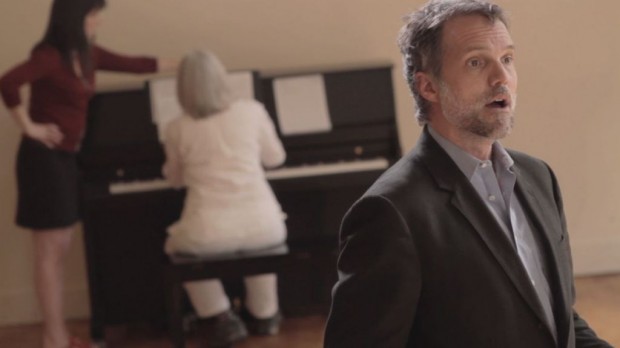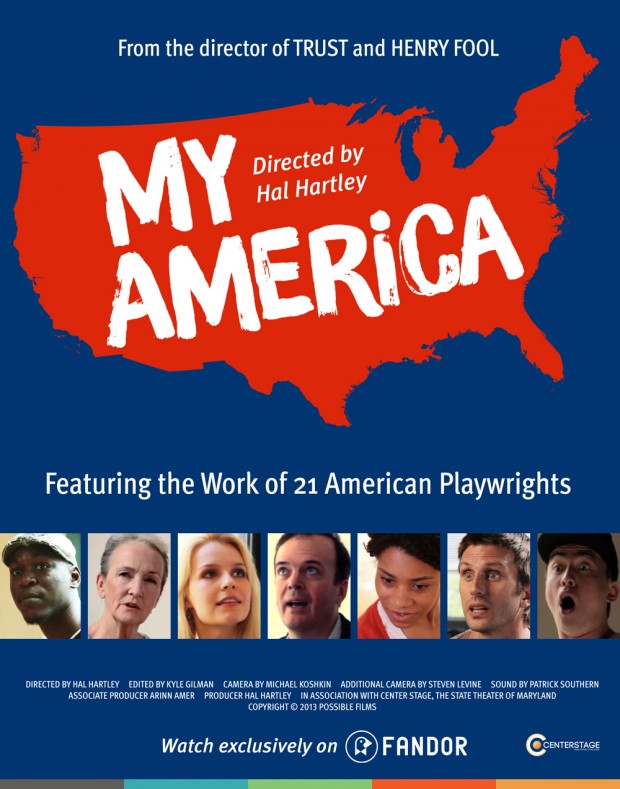
Hal Hartley’s latest, My America, began in collaboration with Baltimore-based Center Stage as a series of monologues written by 50 American playwrights called to create new work around a central theme of “My America” circa 2012. Filmed and edited by Hartley, the series can be consumed in a number of ways — it’s screening theatrically and online via Fandor (which fittingly bowed the film on July 4th), and had previously screened at the IFC Center. Hartley talked with us about his direction of these monologues, trends of downsizing amongst other 90s indie luminaries, and how the new models of distribution and consumption are shaping his work.
Thank you so much for talking with us. Can you tell me how My America came about? It structurally bares some similarities to other films you’ve made.
Well, in 2012 I was hired by Center Stage — which is the state theatre of Maryland — to direct 50 of these small monologues. They had commissioned 50 American playwrights to tackle this issue of what is my America or where is my America? So they had all these monologues and they were going to perform them at the theatre, and they were also going to tape them. I’m friendly with Susan Geller whose a producer there; she’s also the producer of the film and I did it. We shot about six or seven days over the course of a month in rehearsal studio. As we were editing them I got the idea that I could put them together in a line and it would be something interesting and different.
That wasn’t the job. When I was editing the monologues together I asked Center Stage if I could edit a few together and create a feature-length film, and they were all for it. Then it was a matter of talking to the individual play writes and actors involved, that was the hardest part of the process and took the longest. It was satisfying to see that my hunch was correct. There was a lot of great monologues, but some of them were too particular, their subject matter wasn’t appropriate for this kind of entertainment, but they were terrific all by themselves. So creating a 75-minute entertainment of this nature I felt it was important to get at more general concerns. And it’s interesting, 50 playwrights all answering that question, what is my America or where is my America? It was a pretty accurate reading of the nation at that time.
What year was this staged?
They were originally shot in the summer of 2012.
In terms of how they were constructed and edited it feels very cinematic. One thing I’ve noticed is that many filmmakers of the 1990’s including Neil LaBute (whose work is featured in My America) have downsized. His last film Some Velvet Morning was shot in an apartment with two actors verses working with his previous budgets and scope. Can you comment on this trend filmmakers going back to more contained films?
All of these things play into that, technology, new economic model. I’ve never worked within the studio system, and I’ve always made small films before, during, and between my feature films that tended to be more experimental, just because I like to work. I know a certain 90-minute feature film has certain expectations and a short film is a way to play with these ideas.
Technology has changed because people are watching more work on their devices and I really believe people prefer shorter pieces. The notion that a film has be 90 minutes is going away. When I started out the festivals and distributors classified a feature film 90-100 minutes long and now festivals are classifying features as 60 minutes long. My film from a few years ago Meanwhile took advantage of that and its 60 minutes and a feature.
There’s also, of course, experience and aging. When you get older you get curious. If you’re lucky enough – and I consider myself lucky – to have made a living a this, I can pursue my artist aims in the manner I feel is appropriate without shackling myself to the commercial restraints.
What are you working on now?
I just finished a feature called Ned Rifle, which is the third and final part of the Henry Fool trilogy. We’re mixing the audio now.

I know Fey Grim was released day and date by Magnolia while Henry Fool had a more traditional theatrical release [via Sony Classics]. How is your work adapting to these new models. Is theatrical important?
I’ve been working for a long time with adapting these new technologies, or trying make the technologies adapt to my ideas. Back in 2004 that was our idea with The Girl From Monday. We said, ‘let’s make a movie people will watch on a website we design.’ Unfortunately the technology hadn’t quite caught up so we decided to go with a limited theatrical release. I traveled all over the country showing it at art house theaters and then it showed on Netflix.
Now with streaming and the internet being so fluid, it’s a real easy fit for something like My America which is smaller film. Ted Hope and I used Girl From Monday as a kind of reference. It was a successful limited release in selected art house release and followed up by an internet release. That’s the Fandor model. Even distributors like Sony Picture Classics, whom I’ve had a good experience with in the past on Henry Fool and Amateur, we talk and they also believe theatrical release is advertising. The real revenue comes from various kinds of transactional video on demand and subscription video on demand.
I’m not a purest, I think the theater will always be here, but it’ll be more like going to a museum or something. People are comfortable consuming media in new ways.
Is the festival circuit then the “new” theatrical release?
It is fun to go spend a week watching the new films from around the world. I think that will remain. Although most of the time I’m working if I have a film at a festival. If I’m not working then I can go spend a week with other enthusiasts — that’s very cool. Smaller festivals are easier to organize because the costs of prints and shipping have declined. A few ambitious people can put together a really great festival in town.
Alright, thank you so much for your time.
Thank you.

My America is now streaming on Fandor.

